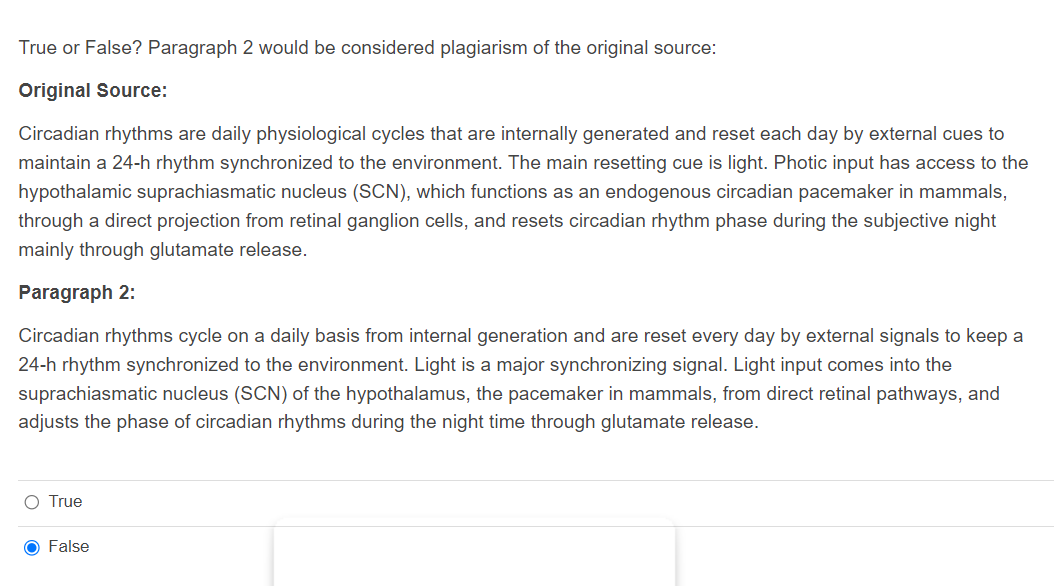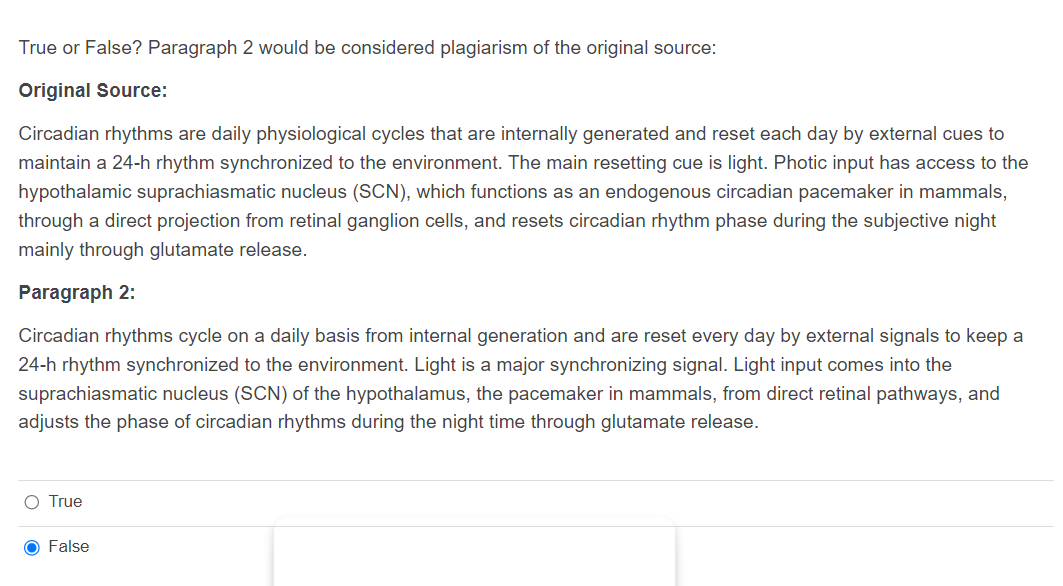True or False? Paragraph 2 would be considered plagiarism of the original source: Original Source: Circadian rhythms are daily physiological cycles that are internally generated and reset each day by external cues to maintain a 24-h rhythm synchronized to the environment. The main resetting cue is light. Photic input has access to the hypothalamic suprachiasmatic nucleus (SCN), which functions as an endogenous circadian pacemaker in mammals, through a direct projection from retinal ganglion cells, and resets circadian rhythm phase during the subjective night mainly through glutamate release. Paragraph 2: Circadian rhythms cycle on a daily basis from internal generation and are reset every day by external signals to keep a 24-h rhythm synchronized to the environment. Light is a major synchronizing signal. Light input comes into the suprachiasmatic nucleus (SCN) of the hypothalamus, the pacemaker in mammals, from direct retinal pathways, and adjusts the phase of circadian rhythms during the night time through glutamate release. O True False
True or False? Paragraph 2 would be considered plagiarism of the original source: Original Source: Circadian rhythms are daily physiological cycles that are internally generated and reset each day by external cues to maintain a 24-h rhythm synchronized to the environment. The main resetting cue is light. Photic input has access to the hypothalamic suprachiasmatic nucleus (SCN), which functions as an endogenous circadian pacemaker in mammals, through a direct projection from retinal ganglion cells, and resets circadian rhythm phase during the subjective night mainly through glutamate release. Paragraph 2: Circadian rhythms cycle on a daily basis from internal generation and are reset every day by external signals to keep a 24-h rhythm synchronized to the environment. Light is a major synchronizing signal. Light input comes into the suprachiasmatic nucleus (SCN) of the hypothalamus, the pacemaker in mammals, from direct retinal pathways, and adjusts the phase of circadian rhythms during the night time through glutamate release. O True False
Ciccarelli: Psychology_5 (5th Edition)
5th Edition
ISBN:9780134477961
Author:Saundra K. Ciccarelli, J. Noland White
Publisher:Saundra K. Ciccarelli, J. Noland White
Chapter1: The Science Of Psychology
Section: Chapter Questions
Problem 1TY
Related questions
Question

Transcribed Image Text:True or False? Paragraph 2 would be considered plagiarism of the original source:
Original Source:
Circadian rhythms are daily physiological cycles that are internally generated and reset each day by external cues to
maintain a 24-h rhythm synchronized to the environment. The main resetting cue is light. Photic input has access to the
hypothalamic suprachiasmatic nucleus (SCN), which functions as an endogenous circadian pacemaker in mammals,
through a direct projection from retinal ganglion cells, and resets circadian rhythm phase during the subjective night
mainly through glutamate release.
Paragraph 2:
Circadian rhythms cycle on a daily basis from internal generation and are reset every day by external signals to keep a
24-h rhythm synchronized to the environment. Light is a major synchronizing signal. Light input comes into the
suprachiasmatic nucleus (SCN) of the hypothalamus, the pacemaker in mammals, from direct retinal pathways, and
adjusts the phase of circadian rhythms during the night time through glutamate release.
O True
False

Transcribed Image Text:True or False? Paragraph 2 would be considered plagiarism of the original source:
Original Source:
Circadian rhythms are daily physiological cycles that are internally generated and reset each day by external cues to
maintain a 24-h rhythm synchronized to the environment. The main resetting cue is light. Photic input has access to the
hypothalamic suprachiasmatic nucleus (SCN), which functions as an endogenous circadian pacemaker in mammals,
through a direct projection from retinal ganglion cells, and resets circadian rhythm phase during the subjective night
mainly through glutamate release.
Paragraph 2:
Circadian rhythms cycle on a daily basis from internal generation and are reset every day by external signals to keep a
24-h rhythm synchronized to the environment. Light is a major synchronizing signal. Light input comes into the
suprachiasmatic nucleus (SCN) of the hypothalamus, the pacemaker in mammals, from direct retinal pathways, and
adjusts the phase of circadian rhythms during the night time through glutamate release.
O True
False
Expert Solution
This question has been solved!
Explore an expertly crafted, step-by-step solution for a thorough understanding of key concepts.
This is a popular solution!
Trending now
This is a popular solution!
Step by step
Solved in 2 steps

Recommended textbooks for you

Ciccarelli: Psychology_5 (5th Edition)
Psychology
ISBN:
9780134477961
Author:
Saundra K. Ciccarelli, J. Noland White
Publisher:
PEARSON

Cognitive Psychology
Psychology
ISBN:
9781337408271
Author:
Goldstein, E. Bruce.
Publisher:
Cengage Learning,

Introduction to Psychology: Gateways to Mind and …
Psychology
ISBN:
9781337565691
Author:
Dennis Coon, John O. Mitterer, Tanya S. Martini
Publisher:
Cengage Learning

Ciccarelli: Psychology_5 (5th Edition)
Psychology
ISBN:
9780134477961
Author:
Saundra K. Ciccarelli, J. Noland White
Publisher:
PEARSON

Cognitive Psychology
Psychology
ISBN:
9781337408271
Author:
Goldstein, E. Bruce.
Publisher:
Cengage Learning,

Introduction to Psychology: Gateways to Mind and …
Psychology
ISBN:
9781337565691
Author:
Dennis Coon, John O. Mitterer, Tanya S. Martini
Publisher:
Cengage Learning

Psychology in Your Life (Second Edition)
Psychology
ISBN:
9780393265156
Author:
Sarah Grison, Michael Gazzaniga
Publisher:
W. W. Norton & Company

Cognitive Psychology: Connecting Mind, Research a…
Psychology
ISBN:
9781285763880
Author:
E. Bruce Goldstein
Publisher:
Cengage Learning

Theories of Personality (MindTap Course List)
Psychology
ISBN:
9781305652958
Author:
Duane P. Schultz, Sydney Ellen Schultz
Publisher:
Cengage Learning